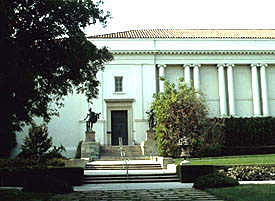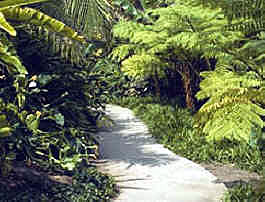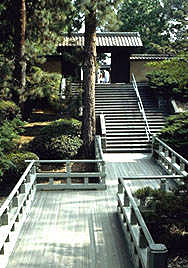Travel
Search
THE HUNTINGTON |
|
Harlan Hague
An east coast friend once asked me to recommend two places to visit that were representative of the best that California could offer. He wanted to see something of the state at the end of a visit that was going to be much too brief and crowded with meetings. I replied without hesitation: Yosemite and the Huntington. There is much to be said for the choice. The first is a magnificent work of nature, the second a premiere example of humankind's stewardship. Both are testaments to the value of preservation. The Huntington is a non-profit educational and cultural center located in San Marino in northeastern greater Los Angeles. It was established in 1919 by Henry E. Huntington, railroad magnate and creator of the "Big Red Cars" that ran on the largest inter-urban system in the country. (Yes, Virginia, Los Angeles at one happy time did have a rapid-transit system.)Happily, Huntington was as adept in his pastimes-- developing his ranch and collecting art and books--as he was in his business. The 207-acre Huntington is actually three attractions in one.
The Huntington's art works are housed in three buildings. The European collections are located in the Huntington Art Gallery, which was originally the Huntington family residence. The collection of British eighteenth and nineteenth century paintings is the most distinguished in the world outside London. The most famous of the works include Thomas Gainsborough's "The Blue Boy" and Sir Thomas Lawrence's "Pinkie," so familiar to Americans that many are surprised to learn that the artists were British. Other notable paintings are Sir Joshua Reynolds's "Mrs. Siddons as the Tragic
Muse," and two paintings by John Constable, "View on the Stour" and
"Salisbury Cathedral." The collection also The Scott Gallery, opened in 1984, houses American paintings. A nineteenth century collection includes the delightful "Breakfast in Bed," by the American impressionist, Mary Cassatt, and a Mississippi River scene by George Caleb Bingham. Landscape art is represented by paintings of Thomas Moran, Asher B. Durand and Frederick Church. Works are displayed by other notable American painters, such as John Singleton Copley, John Singer Sargent and John Sloan. The gallery's collection dates from the 1730s to the 1930s. In addition to the permanent displays of the most famous paintings, both the Scott and Huntington galleries have changing exhibitions. The Arabella Huntington Memorial Collection is located in the west wing of the library building. This memorial to the wife of Henry Huntington includes some exquisite pieces of Sevres porcelain, French sculpture and furniture, and fifteenth- and sixteenth- century Italian and Flemish paintings. Ironically, only this small group of Renaissance paintings from among Arabella's rich personal collections reached the Huntington. At her death, she bequeathed her art works, which she had accumulated during a previous marriage, to her son who distributed them to four libraries, including the Huntington. The remaining pieces in the Arabella Memorial, the bulk of the works, were purchased by Henry after her death in 1924. The gardens are a magnificent complement to the library and art galleries. Fourteen
gardens include more than 14,000 different plants, most of which The twelve-acre desert garden is one of the largest outdoor collections of cacti and succulents to be found anywhere. It contains more than 2,500 species of plants from the world's arid areas. A nearby palm garden includes ninety species from more humid, tropical regions. A stream and waterfall flow through hillside subtropical and jungle gardens. Some of the gardens are representative of man's modification of nature. Plants in the herb garden are categorized according to use: cooking; medicines; wine and liqueur; salads; cosmetics and soaps; dyes; sachets. The Shakespeare Garden displays plants that were common in English gardens in Shakespeare's day. His plays mention most of the plants in the garden. The adjacent rose arbor and garden includes roses dating from the medieval period to modern times, with types from many countries. The Japanese Garden is the jewel of the collection. It is a harmonious blending of plants, falling water and ponds, stone lanterns and vermilion moon bridge in a shallow ravine setting. An authentic, nineteenth century Japanese country house on a hillside completes the scene. The garden is best seen in spring when the cherry trees are in blossom, but it is delightful in any season. After viewing the Japanese house, turn southward (left as you face the house) for the
most dramatic view on the entire estate. A tree-shaded zigzag bridge crosses a dry
landscape. At the far end, a There is a temptation to wander aimlessly through this spacious botanical wonder land, and there is something to said for that, but you will surely miss some of the gardens. Before leaving the orientation center, find the booklet, "An Introduction to The Hunting ton Botanical Gardens," and note the suggested route described there. There are separate guides as well for the library and the three art galleries. Take time to look at the guides before beginning your visit. The restaurant on the grounds is a pleasant place for a self-service lunch or a mid- afternoon break. Seating is both outside in shade and inside. The restaurant also serves a very nice sit-down English tea. Reservations are advisable for the tea. The Huntington galleries are open Tuesday through Friday, 1:00-4:30 p.m. Gardens open at noon. The parking lot, orientation center and bookstore are open 12:30- 5:00. Saturday and Sunday hours are 10:30-4:30. The book store remains open until 5:00. There is no admission charge at this writing, but a voluntary contribution of $7.50 per person is suggested, $6 for seniors, and $4 for children age 12 and under. The charges may become mandatory. For general information, call (818) 405-2100. Telephone (818) 683-8131 for tea reservations. For directions, get a good map of Los Angeles freeways. Find your way to Pasadena on Interstate 210. Exit at Hill Street. Drive south on Hill, then east (left) on Colorado. Turn south (right) on Allen, which ends at the Huntington gate.
|
|
Caveat and disclaimer: This is a freelance travel article that I published some time ago. Some data, especially prices, links and contact information, may not be current. |
|
|
|
|

 features British
drawings, miniatures, sculpture, furniture, and ceramics. One of the most charming works
in the gallery is Jean-Baptiste Greuze's "Young Knitter Asleep," in a collection
of French eighteenth century paintings. Visitors will recognize the only American work in
the main gallery, "George Washington," by Gilbert Stuart. Don't be suspicious if
you have seen a Stuart, "George Washington," elsewhere. He painted many
versions. In fact, there is another in the Huntington's Virginia Steele Scott Gallery.
features British
drawings, miniatures, sculpture, furniture, and ceramics. One of the most charming works
in the gallery is Jean-Baptiste Greuze's "Young Knitter Asleep," in a collection
of French eighteenth century paintings. Visitors will recognize the only American work in
the main gallery, "George Washington," by Gilbert Stuart. Don't be suspicious if
you have seen a Stuart, "George Washington," elsewhere. He painted many
versions. In fact, there is another in the Huntington's Virginia Steele Scott Gallery.  are labeled. Some
gardens feature plant types. The camellia collection is mingled pleasantly with the
statues and an Italian Renaissance stone fountain of the North Vista, a grassy area
bordered by palms, with a view of the San Gabriel Mountains in the distance. Well, on a
clear day in January, you can see the mountains.
are labeled. Some
gardens feature plant types. The camellia collection is mingled pleasantly with the
statues and an Italian Renaissance stone fountain of the North Vista, a grassy area
bordered by palms, with a view of the San Gabriel Mountains in the distance. Well, on a
clear day in January, you can see the mountains.  flight
of stairs leads to a walled enclosure. Before going on, pause here a moment. Then cross
the bridge to the Zen Garden of rock and gravel, raked to symbolize a seascape of islands
and waves. At the far end of the garden, there is a small court where a collection of
bonsai is displayed. Down the hill, contrasting with the close blending of man's and
nature's art of the Japanese Garden, the Australian Garden features an open landscape of
grass, eucalyptus trees, bottle brushes, acacias, and other Australian natives.
flight
of stairs leads to a walled enclosure. Before going on, pause here a moment. Then cross
the bridge to the Zen Garden of rock and gravel, raked to symbolize a seascape of islands
and waves. At the far end of the garden, there is a small court where a collection of
bonsai is displayed. Down the hill, contrasting with the close blending of man's and
nature's art of the Japanese Garden, the Australian Garden features an open landscape of
grass, eucalyptus trees, bottle brushes, acacias, and other Australian natives.